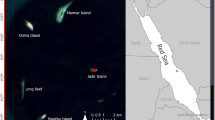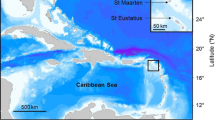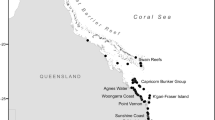Abstract
To investigate site fidelity and homing behavior in juvenile loggerheads (Caretta caretta, L.), a mark-recapture study spanning four years (1998–2001) was conducted in Core Sound, N.C., USA. Each year of the study, approximately half of the turtles captured were tagged and released near the capture sites (n=207), while the remaining turtles were displaced 15–20 km and released (n=198). Loggerheads in both groups were recaptured in equal proportions near the original capture sites and many individuals were also recaptured in subsequent years. These data imply that juvenile loggerheads often returned to their capture sites following displacement, because if turtles dispersed randomly or remained near their release sites, then fewer displaced turtles should have been caught again. Moreover, because turtles migrate out of North Carolina sounds each winter, turtles recaptured at the same locations in different years evidently returned to specific sites following long migrations. To further investigate homing behavior, a small number of displaced turtles (n=28) were tracked using radio telemetry following their release. Although transmitters detached from most turtles within a few days, analyses of initial headings showed strong orientation in the direction of the capture site. In addition, four turtles successfully tracked for longer periods of time all returned rapidly to the vicinity of the capture location and remained in the area. Taken together, the results of this study indicate that juvenile loggerheads exhibit fidelity to specific areas during summer months and possess the navigational abilities to home to these areas following forced displacements and long-distance migrations.








Similar content being viewed by others
References
Able KP (2000) The concepts and terminology of bird navigation. J Avian Biol 32:174–183
Avens L (2003) Homing behavior, navigation, and orientation of juvenile sea turtles. PhD thesis, University of North Carolina–Chapel Hill, Chapel Hill, NC
Batschelet E (1981) Circular statistics in biology. Academic Press, London
Bolten AB, Bjorndal KA, Martins HR, Dellinger T, Biscoito MJ, Encalada SE, Bowen BW (1998) Transatlantic developmental migrations of loggerhead sea turtles demonstrated by mtDNA sequence analysis. Ecol Appl 8:1–7
Burke VJ, Standora EA, Morreale SJ (1993) Diet of juvenile Kemp's ridley and loggerhead sea turtles from Long Island, New York. Copeia 1993:1176–1180
Byles R (1988) Behavior and ecology of sea turtles from Chesapeake Bay, Virginia. PhD thesis, College of William and Mary, Williamsburg, Va.
Carr A (1986) Rips, FADS, and little loggerheads. Bioscience 36:92–100
Carr A (1987) New perspectives on the pelagic stage of sea turtle development. Conserv Biol 1:103–121
Ciofi C, Chelazzi G (1994) Analysis of homing pattern in the colubrid snake Coluber viridiflavus. J Herpetol 28:477–484
Day D (1976) Homing behavior and population stratification in Central Puget Sound English sole (Parophrys vetulus). J Fish Res Bd Can 33:278–282
Dickerson DD, Reine KJ, Nelson DA, Dickerson CE Jr (1995) Assessment of sea turtle abundance in six south Atlantic U.S. channels. Miscellaneous paper EL-95–5, U.S. Army Engineer Waterways Experiment Station, Vicksburg, Miss.
Eifler DA, Eifler MA (1998) Foraging behavior and spacing patterns of the lizard Cnemidophorus uniparens. J Herpetol 32:24–33
Epperly SP, Braun J, Veishlow A (1995a) Sea turtles in North Carolina waters. Conserv Biol 9:384–394
Epperly SP, Braun J, Chester AJ (1995b) Aerial surveys for sea turtles in North Carolina inshore waters. Fish Bull 93:254–261
Epperly SP, Braun J, Chester AJ, Cross FA, Merriner JV, Tester PA (1995c) Winter distribution of sea turtles in the vicinity of Cape Hatteras and their interactions with the summer flounder trawl fishery. Bull Mar Sci 56:547–568
Ernst CH (1968) Homing ability in the spotted turtle, Clemmys guttata (Schneider). Herpetologica 24:77–78
Etienne AS, Maurer R, Seguinot V (1996) Path integration in mammals and its interaction with visual landmarks. J Exp Biol 199:201–209
Ferguson RL, Wood LL, Graham DB (1993) Monitoring spatial change in seagrass habitat with aerial photography. Photogr Eng Remote Sensing 59:1033–1038
Fraker MA (1970) Home range and homing in the watersnake, Natrix sipedon sipedon. Copeia 1970:665–673
Gerking SD (1953) Evidence for the concepts of home range and territory in stream fishes. Ecology 34:347–365
Grassman MA, Owens DW, McVey JP, Marquez RM (1984) Olfactory-based orientation in artificially imprinted sea turtles. Science 224:83–84
Halvorsen M, Stabell OB (1990) Homing behaviour of displaced stream-dwelling brown trout. Anim Behav 39:1089–1097
Hartney KB (1996) Site fidelity and homing behaviour of some kelp-bed fishes. J Fish Biol 49:1062-1069
Henwood TA (1987) Movements and seasonal changes in loggerhead turtle Caretta caretta aggregations in the vicinity of Cape Canaveral, Florida (1978–84). Biol Conserv 40:191–202
Huntingford FA, Braithwaite VA, Armstrong JD, Aird D, Thorpe KE, Joiner P (1998) Social status and growth rates as determinants of site attachment in juvenile Atlantic salmon. J Fish Biol 53:314–321
Keinath JA (1993) Movements and behavior of wild and head-started sea turtles. PhD thesis, College of William and Mary, Williamsburg, Va.
Kenward RE (2001) A manual for wildlife radio tagging. Academic Press, New York
Kramer G (1961) Long-distance orientation. In: Marshall, AJ (ed) Biology and comparative physiology of birds. Academic Press, New York, pp 341–371
Lohmann KJ, Lohmann CMF (1996) Detection of magnetic field intensity by sea turtles. Nature 380:59–61
Lohmann KJ, Lohmann CMF (1998) Migratory guidance mechanisms in marine turtles. J Avian Biol 29:585–596
Lohmann KJ, Cain SD, Dodge SA, Lohmann CMF (2001) Regional magnetic fields as navigational markers for sea turtles. Science 294:364–366
Lutcavage M, Musick JA (1985) Aspects of the biology of sea turtles in Virginia. Copeia 1985:449–456
Mendonça MT, Ehrhart LM (1982) Activity, population size, and structure of immature Chelonia mydas and Caretta caretta in Mosquito Lagoon, Florida. Copeia 1982:161–167
Morreale SL, Standora EA (1995) Cumulative evidence of southward migration of juvenile sea turtles from temperate northeastern waters. NOAA Technical Memorandum NMFS-SEFSC-36. National Marine Fisheries Service, Miami, Fla
Musick JA, Limpus CJ (1997) Habitat utilization and migration in juvenile sea turtles. In: Lutz PL, Musick JA (eds) The biology of sea turtles. CRC Press, New York, pp 137–163
Papi F (1992) General aspects. In: Papi F (ed) Animal homing. Chapman & Hall, London, pp 1–18
Parker RA, Hasler AD (1959) Movements of some displaced centrarchids. Copeia 1959:11–18
Plotkin PT, Wicksten MK, Amos AF (1993) Feeding ecology of the loggerhead sea turtle Caretta caretta in the Northwestern Gulf of Mexico. Mar Biol 115:1–5
Salmon M, Wyneken J (1987) Orientation and swimming behavior of hatchling loggerhead turtles (Caretta caretta L.) during their offshore migration. J Exp Mar Biol Ecol 109:137–153
Schwartz FJ (1978) Behavioral tolerance responses to cold water temperatures by three species of sea turtles (Reptilia, Cheloniidae) in North Carolina. Fla Dept Nat Res 33:16–18
Shoop CR, Kenney RD (1992) Seasonal distributions and abundances of loggerhead and leatherback sea turtles in waters of the northeastern United States. Herpetol Monogr 6:43–67
Sokal RR, Rohlf FJ (1981) Biometry, 2nd edn. Freeman, New York
Stanley MC (1998) Homing in the skink, Oligosoma grande, within a fragmented habitat. J Herpetol 32:461–464
Wallraff HG, Kiepenheuer J, Streng A (1994) The role of visual familiarity with the landscape in pigeon homing. Ethology 97:1–25
Wehner R, Michel B, Antonsen P (1996) Visual navigation in insects: coupling of egocentric and geocentric information. J Exp Biol 199:129–140
Wiltschko R, Wiltschko W (1978) Evidence for the use of magnetic outward-journey information in homing pigeons. Naturwissenschaften 65:112–114
Yoshiyama RM, Gaylord KB, Philippart MT, Moore TR, Jordan JR, Coon CC, Schalk LL, Valpey CJ, Tosques I (1992) Homing behavior and site fidelity in intertidal sculpinds (Pisces: Cottidae). J Exp Mar Biol Ecol 160:113–130
Youngkin DA (2001) A long-term dietary analysis of loggerhead sea turtles (Caretta caretta) based on strandings from Cumberland Island, Georgia. Master's thesis, Florida Atlantic University, Boca Raton, Fla.
Zar JH (1996) Biostatistical Analysis: 3rd edn. Prentice Hall, New Jersey
Acknowledgements
This study was supported by the National Marine Fisheries Service and by grants to L. Avens from the PADI Foundation, Lerner-Grey Fund for Marine Research, and the University of North Carolina-Chapel Hill Wilson Fund. We thank the NOAA Laboratory in Beaufort, N.C., and NMFS for providing logistical support and are especially grateful to J. Keller, J. Weaver, K. Hart, C. Taylor, and many other volunteers for their assistance with turtle capture. We also thank the cooperating pound net fishermen for taking part in this study, as well as C.Taylor, M. Baltzley, L. Boles, W. P. Irwin, C. M. F. Lohmann, C. Mora, and J. Wang for critically reading drafts of the manuscript. This research was conducted under NMFS Scientific Research Permit no. 1260 and USFWS Permit no. TE-676379-2 issued to the NMFS SERO.
Author information
Authors and Affiliations
Corresponding author
Additional information
Communicated by J.P. Grassle, New Brunswick
Rights and permissions
About this article
Cite this article
Avens, L., Braun-McNeill, J., Epperly, S. et al. Site fidelity and homing behavior in juvenile loggerhead sea turtles (Caretta caretta). Marine Biology 143, 211–220 (2003). https://doi.org/10.1007/s00227-003-1085-9
Received:
Accepted:
Published:
Issue Date:
DOI: https://doi.org/10.1007/s00227-003-1085-9




